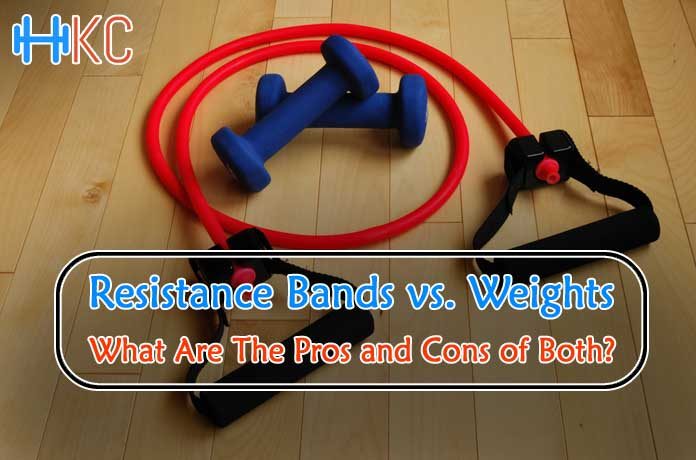
Are resistance bands better than weights? This question has been dividing fitness experts for as long as we can remember, and we don’t seem much closer to an answer that will satisfy everyone.
As with anything, both resistance bands and free weight strength training workouts come with their own set of pros and cons:
1. Force
The first thing to consider when comparing resistance bands and free weights is the force targets muscles and movements to help you get fitter and stronger.
With free weights, the resistance your body is working against is provided by gravity. This means that weights can only activate the muscles in a vertical motion, as gravity pulls the weights down and you work to push them up. Even horizontal weight movements use a downward force to create tension. This makes it vital to position yourself correctly to activate the required muscle when exercising with weights.
On the other hand, resistance bands use elastic tension to create force in any direction the band is being stretched. This means you can actively work muscles in both horizontal and vertical planes, in any direction, at any angle.
2. Building muscle
If you’re asking whether resistance bands or weights are better, you’re probably thinking about building muscle and improving strength.
There have been multiple studies looking into the results achieved when strength training with weights and resistance bands. One of the best to look at is the February 2019 review in SAGE Open Medicine. By looking at a selection of 8 studies (containing small sample sizes and utilizing different exercises), SAGE concluded that resistance bands and weights show very similar results in both upper and lower body exercises.
This means you can effectively build muscle and strength using either option with minimum deviation.
However, another study noted that weights may be more effective at targeting primary muscle groups, whereas bands can work more of the surrounding muscle groups. This is thought to be because bands are less stable compared to weights. That said, the distinction was minimal.
3. Progression
Strength training may be all about “dem gainz,” but how do you measure your gains beyond wrapping a tape measure around your arm to see how much you’ve grown?
With weights, progress tracking is straightforward. Each weight has a set weight, so you always know what force you’re working against. Plus you can simply add/remove weight as you grow more muscular.
Resistance bands, on the other hand, are harder to quantify. For example, a 0.5” resistance band might offer 5-10lbs of resistance. The further you stretch the band, the more resistance will be against you.
The scale of resistance in bands makes it harder to identify precisely what loads you’re working with and/or monitor your progression.
Sure, you can do more reps, but this isn’t quite the same as knowing you’re lifting an extra 2lb weight after X workout sessions!
4. Space
If you can’t get to a gym or want to bring your strength training exercises home, the physical space your equipment takes up is a priority. Most homes don’t have space for a full rowing machine or treadmill, for example.
While free weights are a common sight in home gyms, resistance bands take the edge when it comes to space-saving fitness solutions. The small size of resistance bands means they can easily be stowed away in a bag, drawer, or closet.
Resistance bands made from cotton and latex (like those from Victorem) are also highly durable and lightweight, so you can take your strength training anywhere. As opposed to weights, which generally cause you to be confined to the gym or home.
5. Affordability
Not only are resistance bands more lightweight and compact than free weights, but they also take the prize when it comes to affordability. It’s common for a full set of resistance bands (including multiple difficulty levels) to cost less than 1 set of dumbbells.
Because resistance bands can be used for such a wide range of movements, they gain even more affordability points, as you only need 1 or 2 resistance bands for multiple workouts that might require lots of different weights.
6. Physio and rehab
Resistance bands are a common site in physio and rehabilitation exercises because they put less pressure on your joints while working the muscles. This enables you to build the muscles around joints to strengthen or repair.
The ability to generate elastic force in any direction also enables your body to target stabilizer muscles more effectively in rehab and prehab exercises, like the ones used by NFL star Rob Gronkowski.
Verdict
Overall, both weights and resistance bands provide an effective strength training workout to build muscle.
That said, we must admit that resistance bands seem like a more effective choice for the home due to their small size, lightweight construction, and versatility.
In the gym, free weights and weighted workout machines are probably best as they provide a more straightforward way to track progression.
The best option will very much depend on your unique set of priorities and goals, but we think you’ll probably find the greatest results from using a combination of resistance and weight training in your workouts.











































